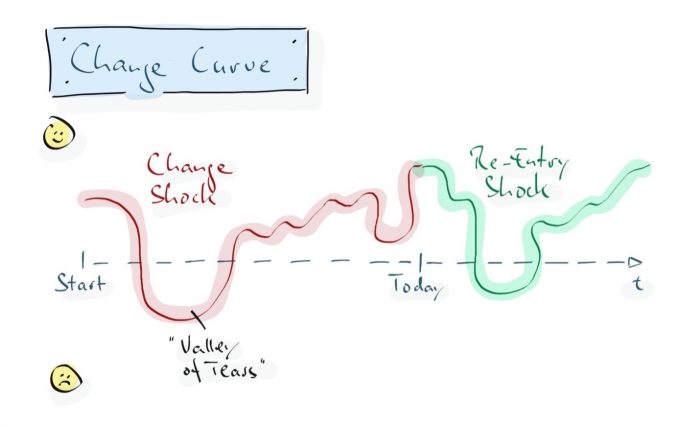THE BENEFITS
“Major changes like those we experienced in the past months take everyone involved on a wild ride.”
Sounds plausible, but this sentence is based on a few assumptions:
- The past months have been a major change. To what extent change is perceived as “major” or “minor” can differ widely between individuals.
- It was a wild ride… The perception of individual highs and lows is likely also very different between one person and another.
- … for everyone involved. Not everyone even feels affected by changes at all, because different aspects matter to them.
It may well be that your teammates have witnessed all kinds of different stories, emotions and learning experiences over the past year. As a leader, please do not assume that everyone is at the same level of (dis-)comfort as you, or as some people you have spoken to. But this variety is exactly where the greatest potential for your team comes from: Discover which lessons learned will be useful for your future collaboration! One fantastic tool to this end is the change curve.
HOW IT’S DONE
Every team member gets a large sheet of paper in landscape orientation and a set of felt markers (if you’re doing this remotely, use a shared whiteboard or hold up your sheets to the camera).
Introduce the task: “Please draw your own curve of the past months on a timeline from left to right. Use your own point of view. Where were the highs, the lows? How intense were they? For each larger amplitude, please take a few notes to explain exactly what happened there.”
Choose the fitting perspective for the task: each of the three following approaches will yield different – yet always interesting – results.
- “Us about us”: The team jointly draws a change curve which reflects the collective highs and lows at a team level over the past months.
Advantage: The creation of the curve itself is an interactive, discussion-intensive process. - “Me about us”: Each team member draws their own version of the team curve – from their own vantage point. All change curves are then compared side-by-side. Discussion follows.
Advantage: You easily visualize different points of view and give each of them space and attention. - “Me about myself”: Everyone creates their own personal change curve. This allows for aspects other than work to enter the picture: challenges such as home schooling or remote work, but also enjoyable experiences. The group can subsequently share and compare, but not discuss.
Advantage: You offer ample opportunity to reconnect on a personal level.

PLEASE CONSIDER
Please do not judge other people’s change curves based on your own experience, and please don’t judge your own based on theirs, either. No personal experience is “right“ or “wrong“ – what matters is to be respectful in getting to know different perspectives.
Be prepared: presenting one’s own change curve can get quite emotional. That’s okay. As a team, you can support each other in this situation.
… and this is only the beginning: Returning to the office and adapting to the “new normal” are the next challenges in line for you and your team. It will feel a little as though everyone had spent some time abroad and had just come back home. People will have changed, and so will their old surroundings – it won’t be like before, although it may look the same.
There is a name for this: “re-entry shock”. One piece of advice for you and your team is to keep drawing the curve: Discuss all these questions in a follow-up session!

